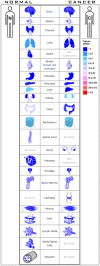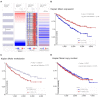Prognostic Significance of Potential Immune Checkpoint Member HHLA2 in Human Tumors: A Comprehensive Analysis
- PMID: 31379814
- PMCID: PMC6644528
- DOI: 10.3389/fimmu.2019.01573
Prognostic Significance of Potential Immune Checkpoint Member HHLA2 in Human Tumors: A Comprehensive Analysis
Abstract
Immunological checkpoint inhibitors have been immensely successfully applied in the treatment of cancer, however, a portion of tumor patients can't benefit from checkpoint therapy. The low PD-1/CTLA-4 positive rate and involvement of multiple immunosuppressive pathways are thought to be one of the reasons for treatment failure in non-responding patients. A new immune checkpoint molecule, HHLA2, which was widely expressed in PD-1 negative human tumors, may be a promising target for the improvement of recent immune therapy. Yet, the prognostic value and transcriptional regulatory mechanisms of HHLA2 remains unclear. In this study, we aimed to evaluate the prognostic value and transcriptional regulation mechanism of HHLA2 according to clinical and experimental data from multiple databases, including cBioPortal, TCGA, Cistrome, TIMER, Oncomine, Kaplan-Meier, GeneXplain. It was found that the expression of HHLA2 was significantly elevated in renal tumors, and significantly decreased in colorectal tumors. Pan-cancer survival analysis indicates that HHLA2 was an independent prognostic factor in 9/20 of human cancers. Especially in renal clear cell carcinoma (P = 3.0E-7). Through plotting survival curve in Kaplan-Meier Plotter, it was found that hypomethylation of HHLA2 DNA was a favorable prognostic factor for KIRC patients. Yet, the copy number variant of HHLA2 was not significantly correlated with the overall survival of KIRC patients. Finally, by analyzing the motif of HHLA2 co-expression genes, we identified 15 transcription factors that may be involved in the regulation of the HHLA2 co-expression network. Among these transcription factors, BATF in B lymphocyte and SMAD in monocyte were confirmed to be able to directly bind to HHLA2 DNA according to chip-seq experimental data from Cistrome database.
Keywords: B7; HHLA2; PD-1; expression profiling; immune checkpoint.
Figures






Similar articles
-
Potential Therapeutic Targets of B7 Family in Colorectal Cancer.Front Immunol. 2020 May 5;11:681. doi: 10.3389/fimmu.2020.00681. eCollection 2020. Front Immunol. 2020. PMID: 32477326 Free PMC article. Review.
-
Upregulated immune checkpoint HHLA2 in clear cell renal cell carcinoma: a novel prognostic biomarker and potential therapeutic target.J Med Genet. 2019 Jan;56(1):43-49. doi: 10.1136/jmedgenet-2018-105454. Epub 2018 Jul 2. J Med Genet. 2019. PMID: 29967134
-
Over-Expression and Prognostic Significance of HHLA2, a New Immune Checkpoint Molecule, in Human Clear Cell Renal Cell Carcinoma.Front Cell Dev Biol. 2020 May 19;8:280. doi: 10.3389/fcell.2020.00280. eCollection 2020. Front Cell Dev Biol. 2020. PMID: 32509772 Free PMC article.
-
Wide Expression and Significance of Alternative Immune Checkpoint Molecules, B7x and HHLA2, in PD-L1-Negative Human Lung Cancers.Clin Cancer Res. 2018 Apr 15;24(8):1954-1964. doi: 10.1158/1078-0432.CCR-17-2924. Epub 2018 Jan 26. Clin Cancer Res. 2018. PMID: 29374053 Free PMC article.
-
KIR3DL3-HHLA2 and TMIGD2-HHLA2 pathways: The dual role of HHLA2 in immune responses and its potential therapeutic approach for cancer immunotherapy.J Adv Res. 2023 May;47:137-150. doi: 10.1016/j.jare.2022.07.013. Epub 2022 Aug 4. J Adv Res. 2023. PMID: 35933091 Free PMC article. Review.
Cited by
-
Construction and Validation of a Novel Immune Checkpoint-Related Model in Clear Cell Renal Cell Carcinoma.Dis Markers. 2022 Dec 30;2022:9010514. doi: 10.1155/2022/9010514. eCollection 2022. Dis Markers. 2022. PMID: 36618968 Free PMC article.
-
Harnessing natural killer cells for cancer immunotherapy: dispatching the first responders.Nat Rev Drug Discov. 2022 Aug;21(8):559-577. doi: 10.1038/s41573-022-00413-7. Epub 2022 Mar 21. Nat Rev Drug Discov. 2022. PMID: 35314852 Free PMC article. Review.
-
Identification of Survival Risk and Immune-Related Characteristics of Kidney Renal Clear Cell Carcinoma.J Immunol Res. 2022 Jul 4;2022:6149369. doi: 10.1155/2022/6149369. eCollection 2022. J Immunol Res. 2022. PMID: 35832648 Free PMC article.
-
Potential Therapeutic Targets of B7 Family in Colorectal Cancer.Front Immunol. 2020 May 5;11:681. doi: 10.3389/fimmu.2020.00681. eCollection 2020. Front Immunol. 2020. PMID: 32477326 Free PMC article. Review.
-
Comparison of mismatch repair and immune checkpoint protein profile with histopathological parameters in pancreatic, periampullary/ampullary, and choledochal adenocarcinomas.World J Gastrointest Oncol. 2024 Mar 15;16(3):875-882. doi: 10.4251/wjgo.v16.i3.875. World J Gastrointest Oncol. 2024. PMID: 38577456 Free PMC article.
References
Publication types
MeSH terms
Substances
LinkOut - more resources
Full Text Sources

